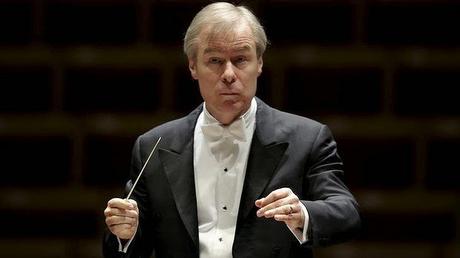by Paul J. Pelkonen

David Robertson. Photo by Keith Saunders © 2015 the Sydney Symphony Orchestra.
On Friday night, a bitter (and hopefully final) blast of snow and sleet welcomed the St. Louis Symphony to Carnegie Hall. The orchestra and chorus are one of North America's strongest and yet underrated ensembles. Despite being the oldest orchestra in the Midwest (they're second only to the New York Philharmonic in terms of overall longevity, St. Louis does not have the glitzy cachet of "big five" orchestras like Chicago or Cleveland. However, they do have a rich sound, a strong work ethic and a music director, David Robertson unafraid of innovative programming.Friday night's concert spanned three centuries, exploring impressionism, modern vocal music and all-out romanticism. The concert opened with Nocturnes, the first orchestral triptych from the pen of Claude Debussy. Mr. Robertson conducted Nuages with great subtlety, cuing the slow, scudding figures in the strings and the key comments from the double reeds.
Fêtes, the fast movement of these three had a richness of tone color and puissance from the brass, particularly in the "parade", a sequence that sounded as if it started offstage and gradually swelled to a climax. Sirènes seemed to hang stilled in time, with the ethereal sound of the women's chorus dying dreamily away.
Debussy wrote Sirènes for a chorus singing vocalise: wordless syllables over a musical accompaniment. Wordless voices are also at the core of Meredith Monk's compositional career, which has been a key part of the New York new music and underground scene for 50 years. WEAVE (which Mr. Robertson premiered in 2010) is written for chamber orchestra, chorus and two amplified singers whose vocals are also altered, echoed, layered and remixed in the course of the performance.
Singers Katie Geissinger and Theo Bleckmann stood at microphones, situated halfway upstage amidst the St. Louis players. They uttered short syllables, single, wordless phrases sometimes with glottal vowels, sometimes without. These built into phrases, overlapping sentences without any meaning, eventually whole paragraphs of sound. Mr. Bleckmann and Ms. Geissinger shared similar vocal ranges, his upper-lying choir tenor contrasting with her bright, agile mezzo.
Ms. Monk built her work organically. Tiny phrases in the opening blossomed into fulsome flowers as the orchestral texture expanded upon itself. Each phrase uttered by the singers was eventually echoed, supported and even supplanted by the chorus and orchestra. Plucked strings, a pair of pianos and an array of tuned percussion provided wordless phrases of their own. Each movement of WEAVE built on the ones that came before. At the end, only the voices remained.
Tchaikovsky's Symphony No. 4 is one of the most over-programmed Romantic symphonies, a work subjected to lazy interpretations. However, Mr. Robertson found the passionate, white-hot fire that burns inside this score, carrying off a performance that pleased even the most jaded listener. With ferocious playing from the brass in the bookending movements and a bit of sly humor in the strings and winds in the famous pizzicato dance movement, this was a powerful and muscular performance of this familiar work.

